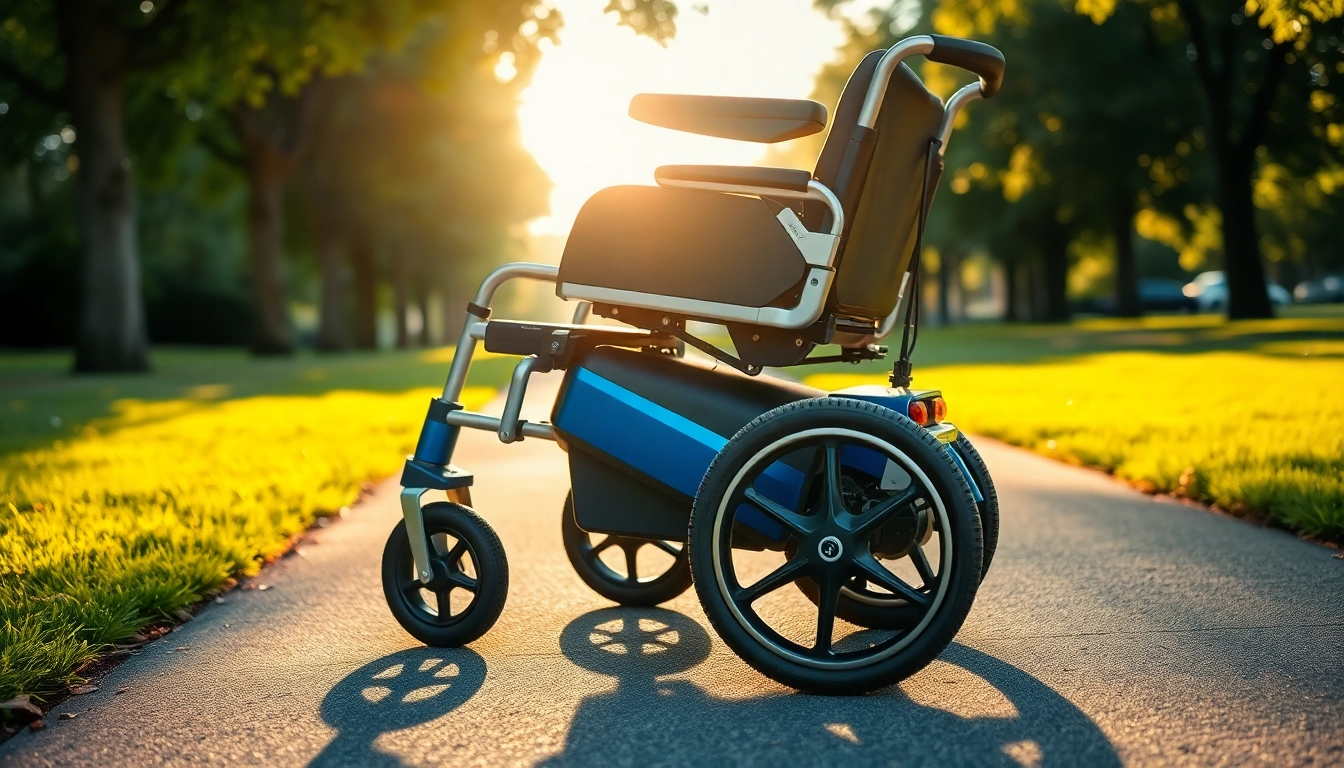Understanding Electric Wheelchairs
Electric wheelchairs, also known as power wheelchairs, are motorized mobility aids that provide individuals with physical disabilities the ability to navigate their surroundings independently and with ease. These advanced devices are designed to enhance mobility, comfort, and quality of life, allowing users to experience greater freedom in their daily activities. With various models and features available, choosing the right electric wheelchair can be a daunting task. This guide will explore the essential elements of electric wheelchairs, helping you understand their functionality, types, and maintenance, and ultimately aiding you in making an informed choice.
What is an Electric Wheelchair?
Electric wheelchairs are specialised chairs that use an electric motor for propulsion, allowing users to move with minimal physical effort. These wheelchairs are equipped with batteries that power the wheels and offer controls via joysticks or other interfaces, enabling smooth navigation both indoors and outdoors. Unlike manual wheelchairs, which require users to self-propel using their arms, electric wheelchairs provide a significant advantage for those with limited upper body strength or endurance issues. The mobility solutions cater to a wide array of mobility challenges, ensuring individuals have access to the world around them.
Key Features to Look For
When considering an electric wheelchair, various features play a crucial role in determining the best fit for your needs:
- Weight Capacity: It’s essential to find a model that supports the user’s weight, ensuring both safety and comfort.
- Battery Life: Look for wheelchairs with long-lasting batteries, allowing for extended outings without the worry of running out of power.
- Terrain Capability: Some electric wheelchairs are designed to handle diverse terrains, including grass, gravel, and inclines.
- Customization Options: Adjustable seating, armrests, and footrests provide optimal comfort tailored to each user’s needs.
- Safety Features: Devices equipped with lights, reflectors, and stability controls help ensure safe navigation.
Common Misconceptions
Despite the growing popularity of electric wheelchairs, several misconceptions persist that can deter potential users:
- Electric Wheelchairs Are Only for the Elderly: Many assume these devices cater solely to an aging population; however, they serve people of all ages with mobility issues.
- They Are Hard to Control: Modern electric wheelchairs feature intuitive controls that are easy to learn, making them suitable for new users.
- They Are Too Expensive: While costs can vary, many affordable options exist, particularly when considering the long-term benefits of independence they provide.
Types of Electric Wheelchairs
Standard vs. Lightweight Electric Wheelchairs
Electric wheelchairs can broadly be classified into two main categories: standard and lightweight models. Standard electric wheelchairs are typically built for durability and can accommodate heavier weights and more robust usage, making them ideal for regular, heavy-duty use. In contrast, lightweight electric wheelchairs offer portability and ease of transport, perfect for users who need a mobility solution that can easily fit in a car trunk or be transported on public transit. Features like foldability and compact design often distinguish the two, enabling users to select models that align with their lifestyle and mobility needs.
Power Wheelchairs for Specific Needs
In addition to the standard and lightweight varieties, electric wheelchairs can cater to specific needs, including:
- Reclining Electric Wheelchairs: These models allow users to recline for comfort, particularly beneficial for those needing pressure relief or specific medical considerations.
- Standing Electric Wheelchairs: Users can transition from a sitting to a standing position, enhancing circulation and mobility.
- Custom-Fitted Electric Wheelchairs: Tailored to individual body measurements and needs, these models provide enhanced support and comfort for those with unique requirements.
Sport and All-Terrain Electric Wheelchairs
For adventure enthusiasts, sport and all-terrain electric wheelchairs offer rugged designs and advanced suspension systems that allow users to explore challenging landscapes. These specialized models cater to outdoor activities, from hiking on trails to navigating through snow or sand. They often come equipped with off-road tires, higher ground clearance, and powerful motors to ensure smooth rides over various obstacles, promoting physical activity and exploration.
Choosing the Right Electric Wheelchair for You
Assessing Your Mobility Needs
Selecting the appropriate electric wheelchair requires a thorough evaluation of your unique mobility needs. Consider the following questions:
- What is the primary use of the wheelchair? (e.g., indoor, outdoor, or both)
- Do you need additional support or custom features based on your medical condition?
- How often will you be traveling or transporting your wheelchair?
- Will you need to navigate through different terrains or obstacles?
Your responses will guide you in identifying the right type and features that align with your lifestyle and limitations.
Considering Budget and Costs
Understanding the costs associated with electric wheelchairs is vital for making a well-informed choice. Prices can vary significantly based on factors such as type, brand, and additional features. On average, the cost of electric wheelchairs can range from a few thousand dollars to over ten thousand, especially for high-end models equipped with advanced technology. Additionally, consider ongoing costs such as battery replacement, maintenance, and possible insurance coverage. Researching financial assistance programs or insurance coverage for mobility devices can also help offset initial expenses.
Testing and Trial Options
Before making a final purchase, it’s beneficial to test multiple electric wheelchair models. Many suppliers and dealerships offer trial periods that allow you to experience the wheelchair’s comfort, handling, and suitability for your daily routine. Focus on the following during your trial:
- How comfortable is the seating and positioning?
- Is it easy to operate the controls?
- Does the wheelchair meet your expected mobility needs?
Gather feedback from your caregivers or family members to ensure a comprehensive evaluation. Testing different environments, like indoors and out, will also provide insight into its real-world functionality.
Maintaining and Caring for Your Electric Wheelchair
Routine Maintenance Tips for Longevity
To ensure your electric wheelchair remains in optimal working condition, follow these routine maintenance tips:
- Battery Care: Regularly charge your battery fully and avoid deep discharges to prolong its lifespan.
- Cleaning: Keep the chair clean by regularly wiping down surfaces and removing debris from wheels and undercarriage.
- Check Tires: Monitor tire condition and air pressure, and replace or inflate as necessary for safe operation.
- Inspect Connections: Periodically inspect electrical connections for wear or corrosion, addressing any issues promptly.
Routine maintenance not only extends the life of your electric wheelchair but also ensures your safety as you navigate through life.
How to Troubleshoot Common Issues
Understanding how to troubleshoot common issues can save you time and inconvenience. Here are some frequent problems and solutions:
- Wheelchair Won’t Move: Check to ensure the battery is charged and that there are no obstructions in the wheels.
- Battery Draining Quickly: Inspect the battery for wear, and consider replacing it if it’s no longer holding a charge effectively.
- Steering Difficulties: Ensure the control interface is functioning correctly and nothing is blocking the joystick or control arms.
If troubleshooting doesn’t resolve the issue, consult your user manual or contact a technician for professional help.
Accessories to Enhance Usage
There are several accessories available that can complement your electric wheelchair and enhance your overall user experience:
- Storage Solutions: Bags, pouches, or baskets can provide convenience for carrying personal items and enhance independence.
- Seat Cushions: For added comfort and pressure relief, consider investing in a high-quality seat cushion.
- Control Modifications: Customized control adaptations can cater to user needs, allowing for enhanced usability.
Choosing the right accessories will ultimately enhance your experience, ensuring you are not only mobile but comfortable and prepared for various situations.
Real-Life Stories and Testimonials
Empowering Stories from Electric Wheelchair Users
The impact of electric wheelchairs on users’ lives is profound. Here are a few stories from individuals who have experienced transformations:
Maria, a 32-year-old artist, recounts how her electric wheelchair allowed her to navigate galleries and meet clients independently. She expressed, “Once restricted to my home, my wheelchair has opened the art world to me. I can attend openings and participate in discussions. My creativity has flourished without boundaries.”
Case Studies on Improved Mobility
Numerous case studies illustrate the life-changing effects of electric wheelchairs. For example, a recent study involving individuals with spinal cord injuries demonstrated that those using electric wheelchairs reported higher satisfaction levels in social engagement and independence compared to manual wheelchair users. The findings suggest that access to mobility aids significantly impacts mental health and community integration.
Community Support and Involvement
Community networks play a crucial role in supporting electric wheelchair users. Various organizations provide resources, support groups, and advocacy for accessibility rights. Engage with local communities or online forums to share experiences and gain insights, ensuring you are connected and informed. These networks foster a sense of belonging and empower individuals to advocate for their mobility rights and accessibility needs.



